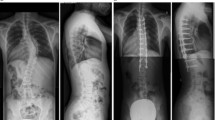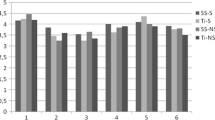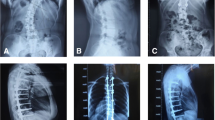Abstract.
Posterior correction and fusion with segmental hook instrumentation represent the gold standard in the surgical treatment of progressive idiopathic thoracic scoliosis. However, there is a debate over whether pedicle screws are safe in scoliosis surgery and whether their usage might enable a better curve correction and a shorter fusion length. The details of curve correction, fusion length and complication rate of 99 patients with idiopathic thoracic scoliosis treated with either hook or pedicle screw instrumentation were analyzed. Forty-nine patients had been operated with the Cotrel-Dubousset system using hooks exclusively ("hook group"). Fifty patients had been operated with either a combination of pedicle screws in the lumbar and lower thoracic and hooks in the upper thoracic spine or exclusive pedicle screw instrumentation using the Münster Posterior Double Rod System ("screw group"). The preoperative Cobb angle averaged 61.3° (range 40°–84°) in the hook group and 62.5° (range 43°–94°) in the screw group. Average primary curve correction was 51.7% in the hook group and 55.8% in the screw group (P>0.05). However, at follow-up (2–12 years later) primary curve correction was significantly greater (P=0.001) in the screw group (at 50.1%) compared to the hook group (at 41.1%). Secondary lumbar curve correction was significantly greater (P=0.04) in the screw group (54.9%) compared to the hook group (46.9%). Correction of the apical vertebral rotation according to Perdriolle was minimal in both groups. Apical vertebral translation was corrected by 42.0% in the hook group and 55.6% in the screw group (P=0.008). Correction of the tilt of the lowest instrumented vertebra averaged 48.1% in the hook group and 66.2% in the screw group (P=0.0004). There were no differences concerning correction of the sagittal plane deformity between the two groups. Fusion length was, on average, 0.6 segments shorter in the screw group compared to the hook group (P=0.03). With pedicle screws, the lowest instrumented vertebra was usually one below the lower end vertebra, whereas in the hook group it was between one and two vertebrae below the lower end vertebra. Both operative time and intraoperative blood loss were significantly higher in the hook group (P<0.0001). One pedicle screw at T5 was exchanged due to the direct proximity to the aorta. There were no neurologic complications related to pedicle screw instrumentation. Pedicle screw instrumentation alone or in combination with proximal hook instrumentation offers a significantly better primary and secondary curve correction in idiopathic thoracic scoliosis and enables a significantly shorter fusion length.
Similar content being viewed by others
Author information
Authors and Affiliations
Corresponding author
Additional information
Electronic Publication
Rights and permissions
About this article
Cite this article
Liljenqvist, U., Lepsien, U., Hackenberg, L. et al. Comparative analysis of pedicle screw and hook instrumentation in posterior correction and fusion of idiopathic thoracic scoliosis. Eur Spine J 11, 336–343 (2002). https://doi.org/10.1007/s00586-002-0415-9
Received:
Revised:
Accepted:
Published:
Issue Date:
DOI: https://doi.org/10.1007/s00586-002-0415-9




